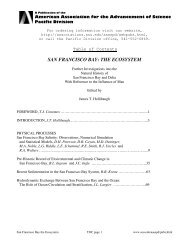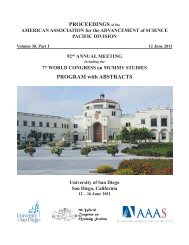Vol 31, Part I - forums.sou.edu ⢠Index page - Southern Oregon ...
Vol 31, Part I - forums.sou.edu ⢠Index page - Southern Oregon ...
Vol 31, Part I - forums.sou.edu ⢠Index page - Southern Oregon ...
Create successful ePaper yourself
Turn your PDF publications into a flip-book with our unique Google optimized e-Paper software.
ABSTRACTS – Symposia<br />
detection of genomic aberrants. Yet, despite the ability to<br />
pinpoint cancer phenotypes that correlate with disease and<br />
treatment outcomes, we are not much closer to determining<br />
how and why particular “omics” expression patterns lead<br />
to disease. Recently, significant evidence has shown that<br />
genomic aberrants such as copy number alterations, deletions,<br />
and single nucleotide variants are associated with<br />
cancers. For example, a set of deletions and gene amplifications<br />
on Chromosome 8 are associated with differentiation<br />
between the basal and luminal breast cancers. These cancer<br />
types have widely different treatment outcomes and survival<br />
prognoses, and show significantly different expression patterns<br />
at the transcriptome and proteome level. Determining<br />
the mechanisms by which these aberrations lead to cancers<br />
is a key goal for both diagnosis and improved treatment.<br />
Yet integration of knowledge across levels, from genome to<br />
transcriptome to proteome to phenotype is extraordinarily<br />
challenging.<br />
We describe an effort to unify “omics” data sets from<br />
human in mouse breast tumor models, and from TCGA<br />
samples now being analyzed via large scale proteomic methods<br />
within the CPTAC consortium headed by the NCI. We<br />
show how data can be unified and analyzed within a genome<br />
browser view to yield new insights about the relationship<br />
between cancer genomes, proteomes, and their resultant phenotypes.<br />
We illustrate with examples of previously unknown<br />
genes that appear involved in specific cancer phenotypes.<br />
79 Oncostatin M Interacts with ECM Components: Implications<br />
for Chronic Inflammation and Tumor Metastasis,<br />
RANDALL RYAN*, BRYAN MARTIN, LILIANA MEL-<br />
LOR, OWEN McDOUGAL, REED JACOB, CHERYL<br />
JORCYK, and JULIA OXFORD (Department of Biological<br />
Sciences, Department of Chemistry and Biochemistry,<br />
Biomolecular Research Center, Boise State University,<br />
Boise Idaho, 83725 USA; randyryan7@hotmail.com).<br />
Oncostatin M (OSM) is a proinflammatory cytokine that<br />
has been reported to promote a metastatic phenotype in cancer<br />
cells via its effects on cell migration, invasion and the EMT.<br />
The ECM has been reported to regulate the properties and<br />
activities of numerous cytokines and growth factors, as well as<br />
the behavior and properties of tumor cells. In the current study,<br />
OSM was observed to bind to ECM components, in vitro, in<br />
a pH dependent fashion. OSM bound to ECM was observed<br />
to be protected from cleavage by tumor associated proteases,<br />
when compared to unbound OSM. In addition, OSM bound to<br />
ECM was demonstrated to induce OSM signaling and target<br />
proteins in breast carcinoma cells that could be inhibited with<br />
an OSM neutralizing antibody. The data suggests that OSM<br />
bound to ECM may play an important role in the acquisition<br />
of chronic inflammation and provides additional evidence for<br />
the role of inflammatory processes in cancer.<br />
NIH/NCRR P20RR016454 and P20GM103408, NASA NNX10AN29A,<br />
ACS RSG-09-276-01-CSM, and Susan G Komen KG100513.<br />
Emerging and Re-Emerging<br />
Infectious Diseases<br />
Wednesday, 8:00 a.m. in DOUGLAS FIR 1 & 2<br />
80 Toxin Production by Methicillin Resistant Strains of Staphylococcus<br />
aureus (MRSA): The Effect of Antibiotics, DEN-<br />
NIS L STEVENS 1,2 *, AMY E BRYANT 1,2,3 , STEPHANIE<br />
HAMILTON 1,3 and YONGSHENG MA 1 ( 1 Department of<br />
Veterans Affairs Medical Center, 500 West Fort Street, Boise,<br />
Idaho 83702; 2 University of Washington School of Medicine,<br />
1959 NE Pacific St, Seattle WA 98195; 3 University of Idaho,<br />
Department of Life Sciences, PO Box 443051, Moscow, ID<br />
83844-305; dlsteven@mindspring.com).<br />
The emergence of MRSA has been associated with a<br />
variety of new types of infections which have been associated<br />
with the production of potent exotoxins. Specifically,<br />
the Panton-Valentine Leukotoxins (PVL), alpha hemolysin<br />
and staphylococcal toxic shock toxin-1 (TSST-1). Early in<br />
the course of the MRSA epidemic it was noted that 50%<br />
of patients with MRSA infections were being treated with<br />
antibiotics to which the organism was resistant. This was<br />
further associated with worse outcomes, prolonged hospitalization<br />
and death. We hypothesized that inappropriate<br />
antibiotics might not only delay definitive treatment but be<br />
associated with enhanced toxin production. We first determined<br />
the susceptibility of these strains to nafcillin, vancomycin<br />
and linezolid and performed growth curves using<br />
a rising gradient of antibiotics. Further, we then measured<br />
gene expression for alpha toxin, PVL and TSST-1 at inhibitory<br />
and sub-inhibitory concentrations of antibiotics. Nafcillin<br />
induced markedly increased gene expression for PVL,<br />
TSST-1 and alpha hemolysin in MRSA despite intrinsic<br />
resistance to this agent. Further, sub-inhibitory concentrations<br />
of nafcillin marked increased gene expression of these<br />
toxins in methicillin susceptible strains of S. aureus (MSSA)<br />
as well. Though linezolid also enhanced toxin gene expression,<br />
toxin production at the protein level was curtailed. In<br />
summary, antibiotic choices markedly affect the virulence<br />
of S. aureus.<br />
81 Yersinia pestis Ompx Virulence Factor and Role in Host<br />
Cell Attachment, Internalization, and Immune Modulation,<br />
ANNA M Kolodziejek 1 *, Scott A Minnich 1 ,<br />
Carolyn J Hovde 1 , and Gregory A Bohach 2<br />
( 1 School of Food Science, University of Idaho, 604 Rayburn<br />
Street, Moscow, Idaho 83844 -2<strong>31</strong>1; 2 Division of Agriculture,<br />
Forestry and Veterinary Medicine, Box 9800, Mississippi<br />
State University, Starkville, Mississippi 39762; akolodziejek@vandals.uidaho.<strong>edu</strong>).<br />
Yersinia pestis is the causative agent of plague. Multiple<br />
virulence determinants contribute to its highly efficient<br />
transmission and pathogenicity. Representatives of a large<br />
Enterobacteriaceae Ail/Lom family of outer membrane<br />
proteins (Omp) are found in the genomes of all pathogenic<br />
70








